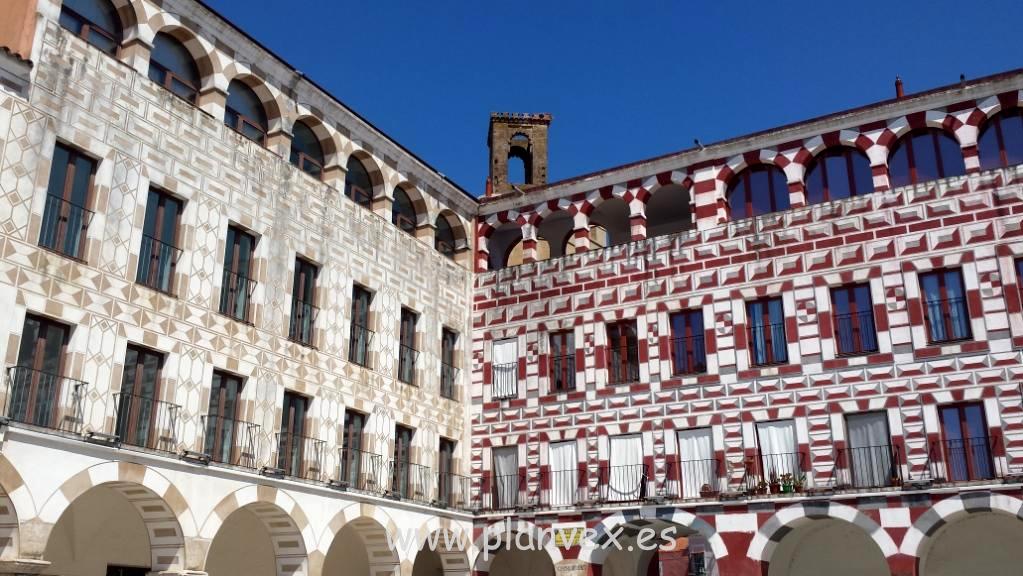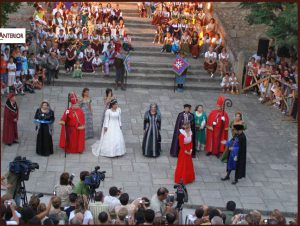
The border of Spain and Portugal at Extremadura, for many years was la boundary that represented the limits of both countries. Today it is a meeting place for Lusitanians and people from Extremadura. Trade, family and cultural relations are a link between two countries that have many similarities.
The fortresses and castles that we find from north to south are witnesses of the historical vicissitudes lived by this land. What unites us is much more than what differentiates us and just a few kilometers from the border find a cultural treasure that maintains ingrained cultural links in both countries. Some outstanding elements can be found in the language, street names, stews and sweets constantly fuse the two countries into one culture.
A Fala, in th “Val of Xálima”
At the Jálama Valley of the Sierra de Gata, a region in Spain, the Portuguese legacy is preserved in its own particular way of speaking. There is a special and autochthonous language, the “Fala”, among the three towns that form of this Valley. This is a romance language of the Galician-Portuguese subgroup. To stroll the streets of “San Martin de Trevejo”, “Eljas” and “Valverde del Fresno” is to enjoy the traditional architecture and rich landscapes, while the water of the Jálama feed the multiple streams and lend its name to the place.
The coexistence between Extremadura and Portugal revives every year on the “Chestnut Festival” celebrated between Eljas, in Spain and Foios, in Portugal. This festivity takes place around the day of “All Saints” in November.
The roman past of Alcántara
Among the best-preserved Roman Bridge in the world is the pride of Alcántara and the whole of Extremadura. The Roman architect Cayo Julius Lacer built this marvel in the second century to unite the borders of the River Tajo. Today it is one of the most visited monuments of the whole region and it also houses many legends around its stones. A visit to Alcántara is an opportunity to get to know the stately homes, Palaces and the convent of San Benito. In passing through remember to try a delicious local sweet called the “mormentera” which is made with honey and almonds.
Coria and the bridge without river
There are several theories that explain why the Coria Medieval Bridge has no water running under its structure. The bridge was constructed in 1518 and built over an earlier Roman bridge. It ´s purpose was to save the waters of River Alagón, but today it rises above orchards that are close to the rivers bank. Some documents speak of the winter flood in the middle of the seventeenth century that caused the diversion of the river to its current channel. Others attribute the deviation of the Alagón to the terrible earthquake that destroyed Lisbon in 1775 and also cracked the Cathedral.
To stop and visit the Cathedral of Coria is an absolute must, which houses a curious and striking relic important to Christianity: the tablecloth of the “Last Supper”. It is a piece of linen of more that four meters, white and with simple ornaments in blue. It is confirmed that it dated from the First Century and is of Arabic workmanship.
 The smallest convent in the world, El Palancar
The smallest convent in the world, El Palancar
Halfway between “Torrejoncillo” and “Cañaveral”, in the Valley of the Alagón River we will find the smallest convent in the world: “El Palancar”, at “Pedroso de Acim”. “San Pedro de Alcántara” (Saint Peter of Alcántara) founded the convent in 1557 and it was his austere refuge. With only 72 square meters, he whole cloister can be explored with only three steps. The cells are of an austere simplicity and lack windows and ornaments. Today it is a place of pilgrimage, retreat and meditation.
The regal wedding at Valencia de Alcántara
The town of Valencia de Alcántara is the living example of the excellent relations of the people that live along the border of Spain and Portugal.

Now, for twelve years, the municipality of Valencia de Alcántara in Cáceres, Spain and the Portuguese town of Marvâo have been celebrating cross-border meetings during the first days in August, culminating in the representation of the wedding between the “Infanta Isabel”, the first born child of the Catholic Monarchs and the King of Portugal Manuel I, also called the Fortunate. The event is called “la Boda Regia” (the Regal Wedding).
This is an excellent opportunity to visit Valencia de Alcántara and immerse into the Spain of 1497, during the Middle Ages. This is a Festival of Regional Touristic Interest and an opportunity to visit the castle fortress and the Church of Our Lady of Rocamador. The palatial and stately houses dot the Gothic-Jewish quarter and make a delightful visit to the old streets.
The arab past of Badajoz
The capital city of Badajoz organizes at the end of every September one of the most unique festivals of Extremadura. It is a fusion of History and culture with gastronomy, music and art: Al Mossassa.
The Islamic past of the city transforms the old town turning it into a Medieval “Zoco” (Souk) flooded with food stalls and Berber handcrafts. The founder of Badajoz, Ibn Marwan, also founded the Portuguese town of Marvâo. This is a good reason for extending the Arab roots of Al Mossassa across the borders to Portugal with numerous activities in both countries.

Your visit to Badajoz requires a stop at the Islamic Wall of the Alcazaba and the Cathedral. Other corner to get lost in your visit to this magnificent medieval city is the “Plaza Alta” and the “Torre Espantaperros”. Badajoz is one of the cities in Spain which is most linked to Portugal.
The folklore of Fregenal de la Sierra
Every summer for 35 year “Fregenal de la Sierra” becomes a melting pot of cultures where music and folklore combine to produce this union. We are talking about the “International Festival of the Sierra”, which has been named a Fiesta of Regional Tourist Interest. The purpose it to have people of different races and belief come together in a festive and joyful atmosphere.
A visit to Fregenal compels us to discover its historic-artistic medieval complex, to get lost while strolling along its wall is delightful visiting churches, sanctuaries and fountains. The architecture of stately houses and palaces guide us to the Templar Castle-Fortress.
The portuguese past of Olivenza
Olivenza was a Portuguese municipality for five centuries and only 215 year ago it became part of Spain. This happened after the “War of the Oranges” in 1801. The special historic situation is constantly lived in this town, considered a sister city of our Portuguese neighbors. You will notice the special ceramic decorations of the tiles, the constantly present Manueline art, the names of the streets and the gastronomy reveal its past.
When visiting the walled city we can see the “Torre del Homenaje” (Tower of the Homage), which is 37 meters high and cross the citadel by acceding through the door of the “Calvario” (Calvary). A must visit in Olivenza is the Church of the “Magdalena” of Manueline style and to walk the medieval wall to photograph the gate of “Alconchel”.
The Medieval Festival of Alburquerque, in Spain
The Castle of “Luna” in Albuquerque, Spain, plays a fundamental role in the events of the town and also, it is fundamental for the Medieval Festival, which is celebrated every summer. During the festival we are moved into the daily life of Christians, Jews and Arabs of the Middle Ages.
Inside the medieval walls this festival offers a busy schedule of markets, parades, concerts and performances to revive the love story between “Doña Ines de Castro” and “Don Pedro Cruz”. To visit Albuquerque is to enjoy the defensive architecture of the walls, to delight in the various hermitages and churches or to be lost in the gothic quarter.
The Passion of Oliva de la Frontera
One of the cultural events with the greatest religiosity and devotion in the region is lived in “Oliva de la Frontera” during the representation of the “Living Passion” during Easter. The event has been declared “Fiesta Regional” of Touristic Interest.
This city becomes the Jerusalem of the first century to tell us the story of the last hours of the life of Jesus of Nazareth. This is a street performance where actors and extras mingle with the audience.
The passage of the different civilizations that settled in this territory have left very little marks that reach our days, however, it is interesting to visit religious monuments and the shrine of “Nuestra Señora de Gracia”(Our Lady of Grace) as well as the parish Church and the Chapel.
A few kilometers from the imaginary line that limit the land of Portugal, we find culture, heritage, history of the two countries that, after many years of living confronting their to their backs, now have turned and look straight at each other.
planVE, la guía de ocio de Extremadura
Original article by Ainhoa Miguel
Translated by Susana Windt
Turismo cultural en Extremadura a un paso de Portugal
Published in December, 2016













